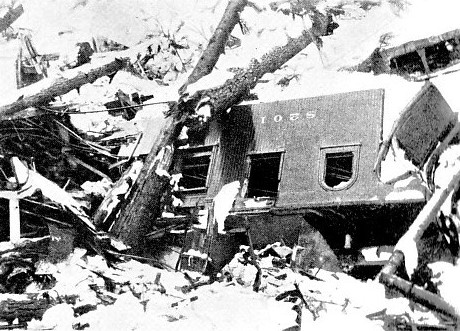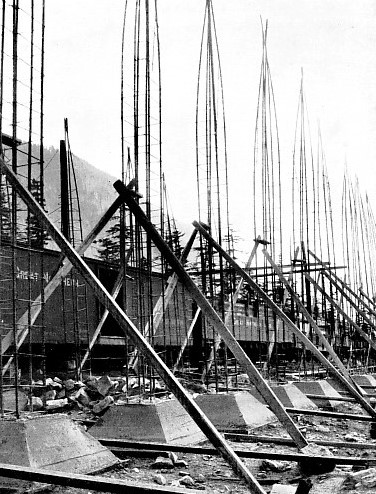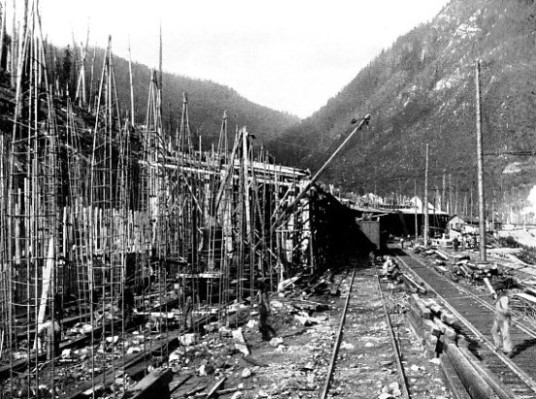
© Railway Wonders of the World 2024 | Contents | Site Map | Contact Us | Cookie Policy


Snow Sheds (2): Ferro-Concrete
How the railways protect their lines from the ravages of snow with costly snow sheds, the latest of which are built in ferro-
NEW CONCRETE SNOW-
The ferro-
the steepness of the mountain sides.
THERE is another dangerous aspect which the engineer dreads. An avalanche, starting its travel from a point high up on a steep mountain side and travelling with fearful speed, may sweep over the shed, without inflicting any damage. It hits the bottom of the depression, but the momentum it has attained is so great that it rushes like a wave of Water for 100 or 200 feet up the opposite mountain wall. When its velocity is expended it drops back, and woe betide the line if it receives this backwash, as it were, for it will be battered to fragments. In some instances the snow-
While huge tree trunks and jagged masses of rock, weighing ten tons or more, are able to knock any human handiwork to smithereens, the “cyclonic wind” which accompanies the avalanche is equally destructive. The snow-
were apparent. Not a thread was tom out of his clothes; no sign of a scratch on his skin, nor even a bruise was distinguishable. Yet when he was examined by the doctors there was not a bone in his body which was not either broken or dislocated.
The Canadian Pacific, however, is but one of the many railways crossing the North American continent which suffers from the devastation wrought by the snow-
So thoroughly was the snow-
The winter of 1909-
The avalanches roared down the mountains continuously. It seemed as if the gulch would be filled with debris brought down from above. The passenger train halted within the portal of the bore and
stood there, with its electric locomotives, for several hours. Then the passengers got fidgety. They dreaded an avalanche sweeping down and blocking their exit entirely. They approached the officials and begged that the train should pull out of the tunnel and down the line for half-
The officials consented, and the train drew ahead to a point where the officials thought there was little danger of a slide descending upon the the line. Here the train stood ready to advance the moment the line was open, the passengers living and sleeping in the Pullmans. A few intrepid travellers, either fretting at the delay or having a premonition of disaster, packed their traps and decided to push afoot to Seattle. They wended their way carefully down the rugged white mountain side, struggling over snow 20 and 30 feet deep, to Scenic, then tramped along the grade for 12 miles to Skykomish, whence they took train over the open line to Seattle.

THE WELLINGTON AVALANCHE DISASTER ON THE GREAT NORTHERN RAILWAY, U.S.A. The largest single fragment of a car that was found.
The stalled train waited all day at Wellington, and the weary passengers at last turned into their berths. In the blackness of the night the snow started to move on the summits above, gathered impetus and weight, and tore down the mountain side, devastating the slopes over a width of half-
No other catastrophe from snow can equal that of the American Great Northern Railroad. Its swiftness and magnitude staggered everyone. A fortnight elapsed before the lines were opened to permit trains to approach the point, although rescue parties toiled over the snow-
Among the first to reach the fatal spot were Mr. James J. Hill, the chairman of the railway, his son Louis, the president, and Mr. A. H. Hogeland, the chief engineer of the system. When they arrived the rescue forces were digging through the ice, rock, and tree trunks, striving to reach the mangled passengers in the splintered and pulverised coaches.
The officials tramped the track for miles and scoured the mountain sides above.
“Whatever the cost the track must be protected against a repetition of this disaster. If it means millions it must be done”, declared the chairman emphatically. “Start at once!”
The chief engineer completed his reconnaissance, and then returned east, preparing, during his journey, his designs for snow-
He decided to introduce a new type of snow-
The rescuers had barely dug down to the wrecked train before large gangs of men appeared upon the track above, commencing operations for the erection of the huge structure which was to enclose the double track in a concrete tunnel. A matter of 3,300 feet of line was to be treated in this manner. All traffic was diverted over side tracks, so as to permit the workmen to continue their labours in gangs, day and night, without interruption.
A somewhat strange spectacle was presented during this work. The sleepy mountain town of Wellington — little more than a hamlet — was alive and bustling. The railway builders were setting the iron frames forming the metallic skeleton, the mixers were toiling incessantly preparing the gravel and cement, and the concrete as rapidly as it was mixed was dumped into the moulds, so that the structure was assuming its form with amazing speed. Down in the valley, where a few dirty patches of snow still lingered, were fragments and splinters of the train which had been hurled to destruction, while the mountain side was scarred with a wide swathe showing where the avalanche had mowed its way.
On the mountain side of the track the rock and loose earth were removed to permit of the erection of a huge monolithic bank of cement, armoured and reinforced with steel rods. On the opposite side, from concrete pedestals sunk into the ground, rose ribs of the same metal, a rod from each corner, and laced together about 12 inches apart. These were encased in wooden boxes into which the concrete was dumped and rammed tightly down, so as to form a homogeneous post of steel, cement and gravel. The tops of the posts were connected and interlaced with the steelwork forming the roof, which on the mountain side was anchored to the massive concrete wall. The latter is some 50 feet in thickness, and, being attached to the rock, forms practically part and parcel of the mountain. The roof of concrete, 10 inches in thickness, and sloping towards the canyon at one foot in five, is 22 feet above the rail level and covers both tracks. The reinforced posts are set 10 feet apart in the six-
By the time the work was completed some 30,000 barrels of cement and 2,400 tons of steel had been worked into the 3,300 feet of shedding, and £100,000 had been expended. An outlay of £30 a foot to protect the track against the ravages of the snow-
 This innovation having proved so successful, other railways have adopted the ferro-
This innovation having proved so successful, other railways have adopted the ferro-
THE NEW CONCRETE SNOW-
You can read more on “The Canadian Pacific Railway -
“Snow Sheds -
